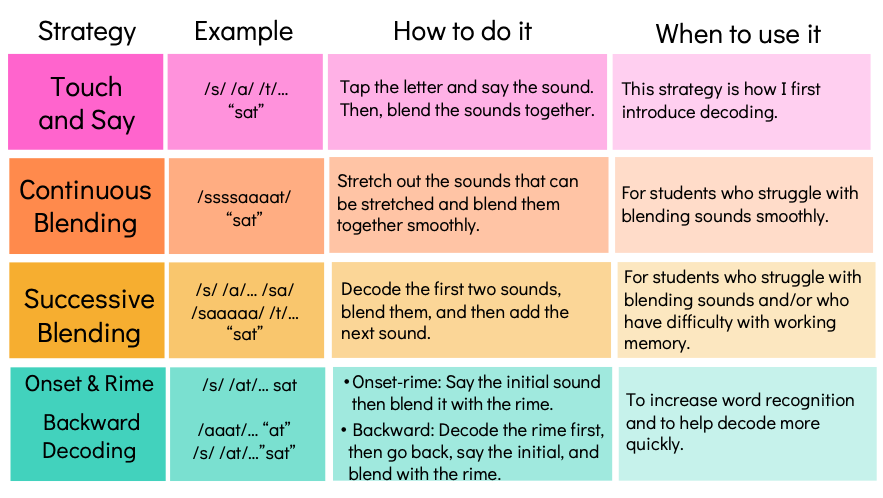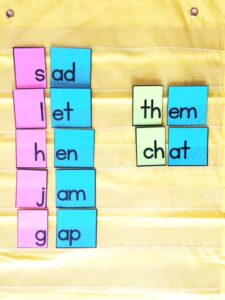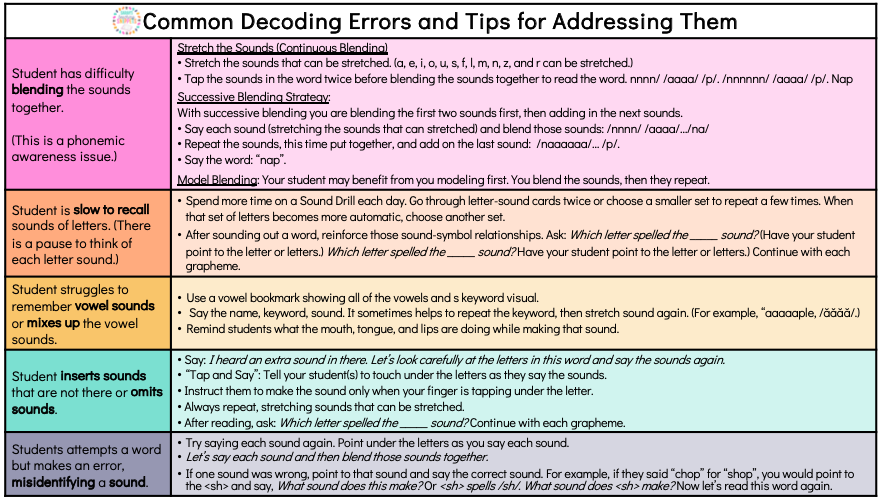Decoding is a crucial skill for beginning readers as they learn to make sense of written words. Decoding requires two essential skills: Phoneme blending and letter-sound knowledge. As soon as students know a handful of letters, they can begin decoding words with those sounds. (Read more about how to integrate decoding into your alphabet instruction here.)
Decoding strategies provide a structured approach to help students tackle words effectively, and teachers or parents should model each strategy and provide guided practice to ensure mastery. By teaching effective strategies, we can help children decode words confidently and develop into fluent readers.
In this blog post, we will explore four decoding strategies. Each strategy offers unique benefits for young readers and plays a crucial role in their journey toward fluency.

Different types of Sounds
Before I go into the decoding strategies, it’s important to note that there are different types of sounds. Some sounds are continuous, while others are stopping sounds.
Continuous sounds are sounds that can be stretched. Examples of continuous sounds include /f/, /h/, /j/, /l/, /m/, /n/, /r/, /s/, /v/, /y/, and /z/. All vowels are also continuous sounds because they can be held without interruption. These sounds allow for a smooth, ongoing flow of air, which makes them easier for students to stretch when blending words.
Stopping sounds can’t be stretched because they’re made by completely stopping the airflow in your mouth and then releasing it quickly. These are quick, crisp sounds with a single burst of air, so there’s no way to hold or extend them like you can with continuous sounds. Stopping sounds include /b/, /d/, /g/ /k/, /p/, and /t/. Since stopping sounds are so quick, it’s important to help students blend them into the next sound right away without adding extra vowel sounds (avoiding “puh” instead of /p/ or “tuh” instead of /t/).
Understanding the difference between these types of sounds is key to teaching decoding strategies effectively, as it helps students learn how to blend sounds together smoothly.
Decoding Strategy 1: Tap and Say
“Tap and Say,” or “Segment and Blend,” involves pointing to each letter, saying each sound, and then blending those sounds together to form the word. For example, with the word “sat”, the student would say /s/ (tap under <s> ), /a/ (tap under <a), /t/ (tap under <t>), and then blend the sounds to say “sat”.
Decoding Strategy 2: Continuous Blending
Continuous Blending involves stretching out the sounds that can be held (like /s/, /m/, or /a/) and blending them together smoothly. For instance, in the word man, the student stretches the sounds like this: mmm…aaa…n. It is much easier to blend the sounds together when you use this method. As I mentioned earlier, not all sounds can be stretched, so this strategy is best when reading words with continuous sounds. Remember, all vowels can stretch, so at the very least, you can always train your students to stretch the vowel sounds.
This strategy minimizes the cognitive load for students, as it avoids separating sounds too much, which can make blending harder. Continuous blending is particularly helpful for students who struggle to put segmented sounds back together.
Decoding Strategy 3: Successive Blending
Successive Blending breaks the blending process into manageable steps. Students decode the first two sounds, blend them, and then add the next sound. For example, with the word “bag”, the student blends /b/ + /a/ to get /ba/, then repeats /ba/ (stretching the /a/) and adds /g/. Read an entire blog post about successive blending here.
The picture below shows some fun ways to practice successive blending.

This is also a helpful strategy when introducing consonant blends. It can be challenging to blend that fourth sound! For example, with the word “flag”, the student blends /f/ + /l/ to get /fl/, then adds /a/, and finally adds /g/.
This strategy reduces the number of sounds a student needs to hold in their working memory at one time. It is also helpful for students with weak or developing phoneme blending skills. They may not be able to blend three sounds but may be able to blend two.
Decoding Strategy 4: Onset and Rime and Backward Decoding
Backward decoding and onset-rime decoding are distinct strategies that focus on helping students decode words by analyzing word patterns.
Backward decoding involves starting with the ending sounds or rime of a word (vowel and everything after it) and working backward to the beginning. This strategy emphasizes recognizing familiar rimes, which can be particularly helpful for building word recognition and decoding skills. For example, a student may read “sat” like this: /aaat/…”at”…/s/ /at/…”sat”.
Onset-rime decoding, in contrast, starts with the onset (the initial consonant or consonant cluster) and moves forward to the rime (the vowel and any following consonants). For example, in the word “cat,” “c” is the onset, and “at” is the rime. This is great for kids who can quickly read word endings accurately.
While both strategies emphasize the rimes in decoding, they differ in approach. Backward decoding works from the end of the word to the beginning, while onset-rime decoding begins with the onset and moves forward. By focusing on common rimes, students can build connections between words, making it easier to recognize them quickly in the future. This focus on patterns not only aids in decoding but also supports the development of automatic word recognition over time.
Use this strategy with students who need to work on word recognition. These students may be proficient with blending sounds and sound-symbol relationships but may not have automatic word recognition. This strategy can also be helpful for students who are prone to guessing because it may slow them down a bit. It also gets them in the habit of finding the vowel in the word since that is where the rime begins.
Want a fun variation? Use index cards to match onset and rime like the picture below. You can simply try to have your students match to see how many words they can make or make it a game of Memory.

Tips for Addressing Common Decoding Errors
Decoding errors are a natural and expected part of the learning process. Successful decoding relies on two key skills: strong phonemic awareness and a solid understanding of sound-symbol relationships. When one of these foundational skills is underdeveloped, errors are more likely to occur. These mistakes provide valuable insight into where a student may need targeted practice or support, allowing teachers and parents to address specific gaps and strengthen overall reading skills.
Here are some tips to address common challenges:

Click here to download a printable version of these Decoding Tips.
Other Tips
Guessing: If a student has a habit of guessing based on the first letter or context rather than decoding, prompt them to tap each sound. Say, What sound does this letter spell? Continue with the whole word. Then say, Now you touch and say, then blend those sounds together.
Confusing Similar Words: It is not uncommon for students to mix up words that look similar. Practice decoding pairs of similar words (sit, sat, sad, sap, sip) to strengthen attention to detail.
Identifying the root cause of decoding errors is crucial for addressing them effectively. The two key areas to examine are letter-sound recognition and phonemic awareness—the ability to blend sounds into words. Providing explicit instruction in letter-sound relationships, following a logical scope and sequence, and incorporating consistent review are essential steps for building a strong foundation. For more insights, read about effective phonics Instruction here. Looking for ready-to-use support? Access detailed lesson plans for phonics instruction here.
Struggling with Long Words:
This post is mainly about decoding for beginning readers. Many students may have difficulty when they transition to reading multisyllabic words. Teaching students strategies to break the word into smaller parts and teaching common morphemes (bases, prefixes, and suffixes) can be helpful. Read this post to learn more about decoding multi-syllable words.
By teaching and practicing these decoding strategies, we equip young readers with the tools they need to confidently tackle unfamiliar words. Remember to observe your students closely and choose the strategy that best fits their needs at the moment. With time and practice, these strategies will become second nature, helping students become skilled and independent readers.









